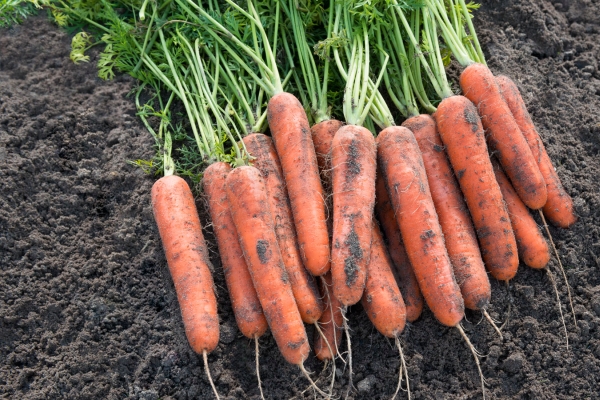Samson carrots are very fond of Russian gardeners because of its taste and simplicity in the care. Samson refers to the mid-season varieties of carrots.
Table of contents
Description and characteristics of the variety
Description and characteristics of Samson carrots:
- harvesting period - 110 days from the first shoots;
- a cylindrical root with a blunt end, reaches 20 cm in length;
- weight - 120-150 grams;
- the main characteristic of the variety is the orange juicy flesh, very sweet, without voids;
- the leaves are bright green with a half-spiked rosette;
- crop yield, with 1 square. meters can get up to 8 kg;
- the carotene content is 11.5%, and the dry matter content is 10.6%.
Advantages and disadvantages of carrots Samson
The advantages include:
- high yielding;
- unpretentious care;
- the variety is grown in both the southern regions and in Siberia;
- blunt end never rot during prolonged storage;
- ideal for making juices, mashed potatoes, fresh consumption and for pickling cabbage, as the variety is very juicy and produces a large amount of juice.
The disadvantages include only one: Samson carrot seeds, because of their popularity, are very difficult to find in stores.

Preparing the soil for sowing
Carrots - cold-resistant culture. Planted in open ground at the end of April or before winter. Planted before winter, when the air temperature drops to +5 degrees.
The soil for sowing should be loose, fertile or sandy with neutral or weakly acid reaction. Before sowing it is necessary to get rid of weeds.
The clay soil forms an earthy lump when it dries out, which makes it difficult for the seeds to germinate.
The soil must contain a sufficient amount of organic matter and trace elements, have a good drainage system and should not be very heavy.
With a lack of organic and mineral fertilizers there is a slowdown in growth. With an excess of organics there is a massive increase in green mass and the emergence of the worst enemy of the root - carrot flies.
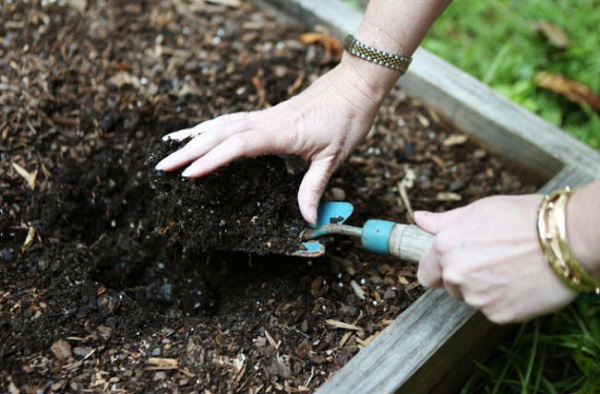
Where to get seeds?
Many gardeners ask: "Where can I get the seeds?". The first option, the easiest - in the store, the second - to grow independently.
For self-cultivation, it is necessary to plant the root crop "saddle". A medium-sized root vegetable is kept in a warm place for several days at the beginning of spring and then planted in the ground.
Vegetable gives roots and eventually throws the arrow, similar to dill, which formed the seeds. In the fall, the arrow is cut, the seeds are cleaned. from debris and leave for storage until planting.
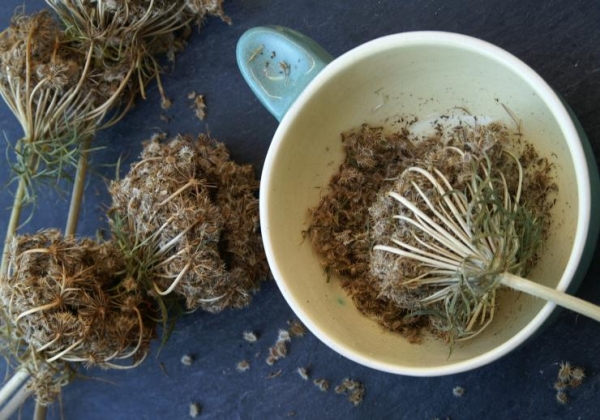
Landing rules
Sowing can be done both in spring and in winter.. For quick germination, you must follow simple rules.
Conduct heat treatment: the seeds are wrapped in a rag and dipped for a few minutes in hot water, and then immediately in cold water.
This procedure allows the seeds to quickly rise and protects them from all sorts of diseases.
Sowing:
- they make furrows, tamp them up and spill them well;
- sowing is carried out at a depth of 1.5-2 cm;
- distance between seeds - 2 cm, between rows - 20-25 cm;
- after sowing, the seeds are immediately covered with earth, so that the soil does not dry out, and they are well spilled with warm water, by sprinkling.
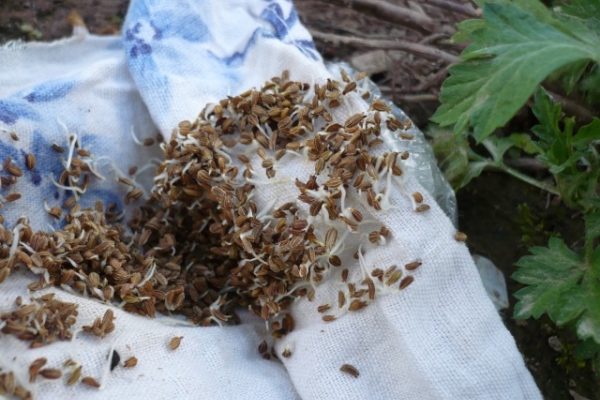
Care
Samson root crop is not whimsical to care, but like other plants needs constant watering.
Weed removal should be carried out only after watering.
Thinning and weeding done twice per season. If you do not adhere to this rule, the carrots will be ugly, and the harvest is pitiable.
First weeding produced when shoots appear. It is convenient to do this with tweezers. Before the procedure, the bed is shed and the shoots are pulled out strictly upwards, leaving a distance of 2-3 cm between them.
The second is carried out 20 days after sowing seeds, when the plants grow 7-8 cm. Thinning is best done in the evening or in the morning.
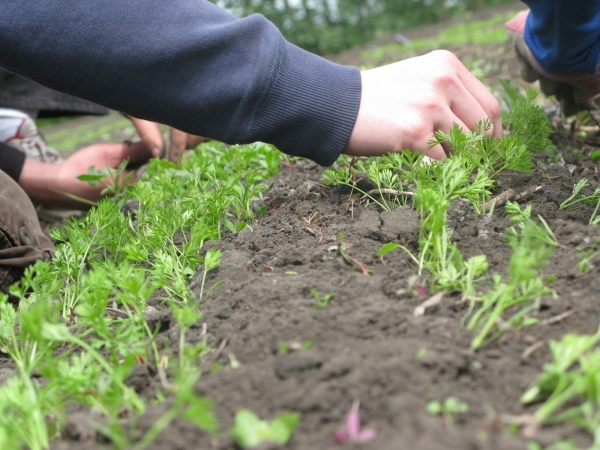
Disease and Prevention
Common carrot diseases include:
Fomoz
Fungal disease - the fork of the stems is defeated, forming gray-brown spots. Necrotic spots make the stem brittle and dry. From the tops of the fungus penetrates the root.
The disease is dangerous for the root, which is grown to form seeds. In case of late recognition of the disease, the fungus infects the whole bed of seed plants.
Phosphorus and potash fertilizers reduce the risk of all fungal diseases, and an excess dose of nitrogenous fertilizers - contribute to the appearance of fomoz.

Black rot
The disease is caused by a fungus.. The disease occurs when the weather is wet and hot. Black rot leads to a decrease in sugar and keratin in carrots. The plant dries up, and the root grows small and ugly.
The disease spreads quickly with air humidity - 85% and air temperature above +20 degrees. The treatment is in the treatment of plants with a solution of "Falcon" and "Prozaro".
Brown spot
The first signs of the disease can be found on the leaves.. The leaves become brittle and become a dirty-brown color. The disease leads to rotting of the root.
Prevention of all diseases:
- plant carrots in the same place can only be at the coming of four years;
- infected plants are burned immediately;
- before planting need disinfection of seeds;
- spraying the plants with the solution “Immunocytophot” or “Epin-extra”;
- timely feeding of plants;
- seed plants must be taken only from healthy plants.
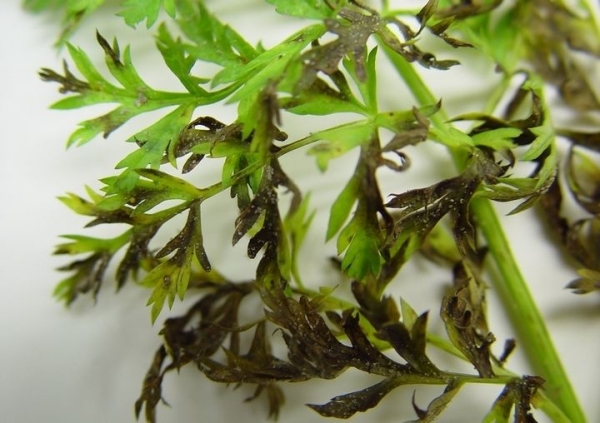
Harvesting and storage rules
Samson carrots should be collected only in dry weather, when the diameter is at least 1 cm in diameter. In the autumn, before the start of the frost harvest the entire crop. The tops are cut at the level of the head of the root.
The optimal temperature for long-term storage is +1 degree. Carrots are placed in boxes, sprinkling each layer of wet sand. It is necessary to ensure that the vegetables do not touch each other.
With proper preparation of seeds for sowing and following the rules of care, Samson carrots will delight their rich harvest and taste.
